
Gulls and Terns
Various species of gulls and terns can be seen year-round in Oregon.

Types of Gulls and Terns

This is a marine gull that breeds on both offshore islands and rocky cliffs along the Oregon Coast. It also uses structures for nesting and, occasionally, will nest on grass-covered headlands.
The Western gull's food comes from the marine environment, estuaries, and the immediate shoreline. It eats small fish, clams, mussels, bird eggs, the young of other birds nesting nearby, sea urchins, starfish, squid, crustaceans, marine worms, and carrion. it will scavenge garbage or waste from fishing boats as well.
It is present all year along the entire coast of Oregon.
Hear the call of the Western gull
Photo by Dave Budeau, ODFW

This gull nests on offshore islands, rocky coastal cliffs, and sometimes in grass on level parts of headlands. It forages in the marine and intertidal environments.
Glaucous-winged gulls eat just about any animal material they find. They take small fish, barnacles, molluscs, sea urchins, bird eggs, carrion and animal waste discarded from fishing boats.
It is rare but regular along the coast and the Columbia River; local and rare in the Willamette Valley. In can be uncommon midwinter at Sauvie Island. Most Glaucous-winged gulls in Oregon nest in the mouth of the Columbia River.
Hear the call of the Glaucous-winged gull
Photo by ©Greg Gilson

This large arctic gull visits the Northwest in winter where its pale bulk often stands out in gull flocks. Finding one is a highlight of winter birding. Even at a distance the size and frosty tones of this bird can be spotted in a flock. Most Oregon birds are in the whitish first-or-second-year plumage showing a pinkish bill with sharply delineated black tip, but third-year birds and adults occur now and then, mainly on the north coast and at Sauvie Island.
They are rare but regular along the coast and the Columbia River, and rare in the Willamette Valley. It has the usual eclectic feeding habits of large gulls, and is usually at home at dumps, beaches and river fronts.
Hear the call of the Glaucous gill
Photo by Richard Mittleman, Flickr

The striking tri-colored upperwing pattern on this graceful little gull is diagnostic in all plumages - a bold white triangle bordered by black outer primaries and gray back and inner wing.
The Sabine's gull is most often observed flying in a steady migration over the ocean, and is seen seldomly foraging offshore. When ashore, it is found about coastal estuaries and inland lakes and impoundments picking food from the surface of the water, tidal flats, and along inland mud flats and shore edges.
In Oregon, it is is a common to abundant spring and fall transient over the continental shelf well offshore. It is irregular but fairly common in fall, as well.
Hear the call of the Sabine's gull
Photo by Alan Vernon, Flickr
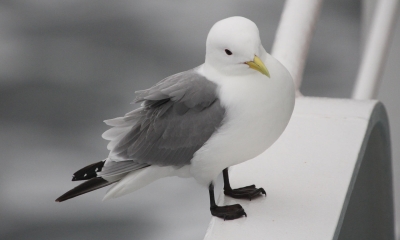
These small agile gulls are predominantly pelagic, but can often be seen from shore and even idling around lower estuaries. It is found primarily on salt water and does not usually forage in dumps and pastures as most gulls do; rather it stays over open ocean, along beaches and in lower estuaries, sometimes resting on the water or on jetties, sand spits and similar bare areas. They are often attracted to feeding swarms of loons, pelicans, tubenoses and other seabirds.
The Black-legged kittiwake is a migrant and winter resident in Oregon along the outer coast and offshore. Peak numbers are seen from boats and along the outer coast during migration.
Hear the call of the Black-legged kittiwake
Photo by Michael Horn, Flickr
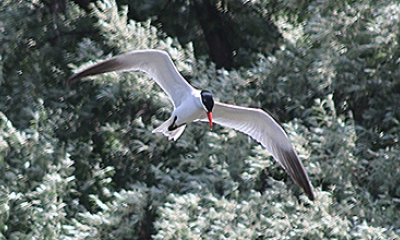
The Caspian tern nests on flat sandy or gravelly areas on islands, or on the margins of lakes, rivers, and marshes. It is always near water, and forages both in nearby water bodies and on prey exposed in nearby open areas.
Breeding colonies in recent years have been on islands in the Columbia River east of the Cascades in north central Oregon; Malheur and Harney lakes in southeast Oregon; Summer Lake and lakes in the Warner Valley in south central Oregon. Most colonies have a history of intermittent use.
It is a locally common summer resident during breeding season within foraging distance of nesting colonies and rare elsewhere. It is fairly common in bays and estuaries along the coast during spring and fall migration. Smaller numbers are found on inland waters during migration, including mid-Columbia, Willamette, and Snake rivers, large lakes in the western interior valleys, and lakes and reservoirs east of the Cascades and in south central Oregon.
Caspian terns are Oregon Conservation Strategy Species in these ecoregions: Coast Range, East Cascades, Northern Basin and Range, and Nearshore.
Hear the call of the Caspian tern
Photo by Kathy Munsel, ODFW

This is Oregon's smallest breeding tern, with black head and body and gray wings during the breeding season. Black terns are delicate, graceful fliers, reminiscent of a nighthawk or swallow.
The Black tern breeds in marsh wetland complexes of southeast, south central and central Oregon. In western Oregon, a very small breeding population is found at a few sites in the Willamette Valley.
Hear the call of the Black tern
Photo by Bob, Flickr
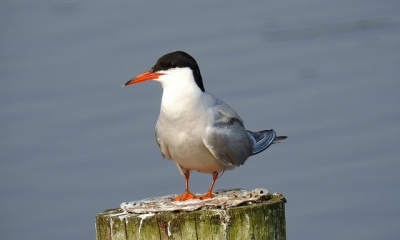
This is a small tern most often seen along the coast flying along the beaches or hovering and diving over a school of fish just offshore. Breeding-plumage adults have sharp black caps, reddish bills, and forked tails, and are pale grayish above and white to pale gray below.
They are a common to abundant spring and fall transient over the ocean, usually within 15 miles, irregularly along the coast and in the estuaries. Nearshore and inland flocks are often observed resting in compact flocks on nearby shores or on floating objects, or flying about over the water in search of fish.
Hear the call of the Common tern
Photo by Corine Bliek, Flickr

The nasal meow of the Franklin's gull can be heard as it soars above wetlands and meadows, and colonies of this species are reported to be the loudest of all the gulls. In breeding plumage, the black hood contrasts sharply with the white breast and bright red bill. This species depends much more on insects and other invertebrates than do other gulls, and is therefore considered economically beneficial and favored by farmers.
The Franklin's gull occurs in the southeast portion of the state in spring and summer, especially Harney Basin. It is rare west of the Cascades. It nests locally in most years only at Malheur National Wildlife Reservoir and Hart Mountain National Antelope Reservoir.
This gull is an Oregon Conservation Strategy Species in the Northern Basin and Range ecosystem.
Hear the call of the Franklin's gull
Photo by ©Keith Kohl, ODFW
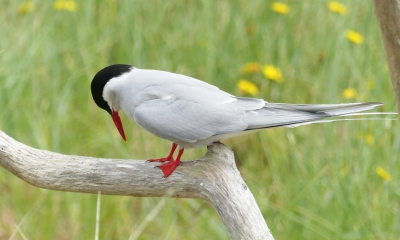
This graceful tern, with its aerodynamic body and streamlined wings, is infrequently seen from land in Oregon. It is most often encountered at sea as it makes one of the most incredible journeys in the animal kingdom, migrating from the Arctic to the Antarctic and back again each year, a journey of nearly 22,000 miles.
A medium-sized bird with a reddish bill, it has a black cap and nape, and a white throat and cheek shading to a light gray body.
It is a common offshore transient in Oregon waters and an occasional migrant along the coast. The bulk of the population is thought to migrate 10-40 miles from land.
Hear the call of the Arctic tern
Photo by Jan Preston, Flickr

Graceful and tern-like in many of its actions, this striking little gull displays flashing white outer primaries that contrast with a gray back.
The Bonaparte's gull is an abundant spring and fall transient along the coast, primarily over the ocean just offshore and is fairly common and widespread elsewhere in Oregon, usually in flocks of less than 100. Larger flocks of up to 1,000 have occurred at Fern Ridge Reservoir in Lane County, during extreme storm conditions, and in the Klamath Basin.
Hear the call of the Bonaparte's gull
Photo by Martyne Reesman, ODFW

Terns are generally associated with marine environments and salt marshes, but the Forster's tern inhabits freshwater areas.
During the breeding season this graceful bird is eastern Oregon's resident small white tern. Typical of terns, the Forster's employs a dramatic hunting method of plunge-diving into shallow waters to capture small fish, the bird sometimes submerging completely.
This is an uncommon but highly visible colonial breeder east of the Cascades.
Hear the call of the Forster's tern
Photo by Dave Budeau, ODFW

Heermann's gulls, the warm-water gulls of summer and fall, accompany Brown pelicans as they fly north each summer.
Although most feed along the shore or in the ocean, some feed on tide flats. They often steal food from Brown pelicans. They may take fish directly from the pelicans' bills immediately after a dive or claim food that pelicans have located, discarded, or disturbed.
This gull is common on the outer seacoasts, beaches, bays and estuaries. They are strongly associated with outer coasts and adjacent ocean waters, usually within a few miles of shore. A few wander inland during the fall southward retreat.
Hear the call of the Hermann's gull
Photo by ©Keith Kohl, ODFW

A slender, orange bill, pearl gray upperparts, and fringed black crest adjoining a white face and neck indeed render this graceful hunter from the south elegant. The foreheads of adults turn white in post-breeding plumage, their usual state in Oregon.
These terns frequent quiet waters or lagoons when diving for fish, but also dive in calm ocean waters. They roost with flocks of gulls and other terns on coastal spits, estuarine sandbars, and on mudflats close to bay mouths.
Virtually all records of the Elegant tern in Oregon are coastal or within half a mile of shore. None have been reported inland.
Hear the call of the Elegant tern
Photo by Ingrid Taylar, Flickr

This small, gentle looking gull is one of the most abundant wintering gulls along the Pacific coast. It is often found foraging in mixed flocks with Ring-billed, and to a lesser extent, California gulls. Its small plover-like head and bill, and the habit of bobbing its head while walking, make it fairly easy to identify.
It is most often found actively foraging with similar-sized gulls on coastal farm fields and short grass meadows and lawn when such habitat is moist.
This is an abundant migrant and winter visitor along the coast, the lower Columbia River and in the Willamette Valley. It can also be seen, occasionally, in the summer.
Photo by Mick Thompson, Flickr
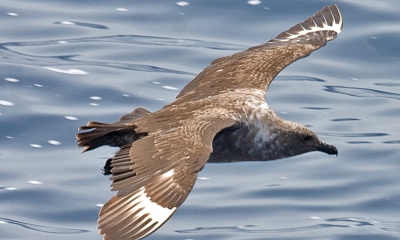
Skuas are the size of a Western gull, dark with a pale nape and large white patches on the bases of the primaries on both the upper and lower surfaces.
This is a solitary bird. Its flight is low and direct with heavy flapping and little gliding. It steals food from other seabirds, and is aggressive, bordering on predatory. It may grab a shearwater's head, wing, or tail and shake and kick the bird until it regurgitates its food.
Chances of detection are best around flocks of shearwaters feeding behind fishing boats. It is a rare to uncommon fall transient offshore. Skuas arrive in late June and are present in low numbers from late July-Aug to mid October.
Hear the call of the South polar skua
Photo by Tony Morris, Flickr

This is a colonial species that uses rocky islands or spits in large freshwater marshes, lakes, and rivers for nesting. It may fly at least five miles from the nest to forage in marshes, rivers, pastures, or other open habitats.
There are colonies of Ring-billed gulls at marshes of southeastern Oregon and on islands in the Columbia and Snake rivers. There has been a colony near Baker City for over 20 years.
Hear the call of the Ring-billed gull
Photo by Kathy Munsel, ODFW

These, the most numerous jaegers off Oregon, are slightly smaller than Herring gulls. Gull-like and graceful, these piratical birds steal food from smaller seabirds. They come in a bewildering array of light and dark individuals, confounded by age and sexual differences.
The Pomarine jaeger is an uncommon spring and fairly common fall transient offshore two to 50 miles, following shearwaters. Sightings have been centered near the continental shelf edge. They are occasionally observed from shore in fall.
Hear the call of the Pomarine jaeger
Photo by Martyne Reesman, ODFW

California gull colonies are usually located on islands with no vegetation in lakes or rivers. Sometimes colonies are on the shore, but these are subject to increased predation from mammalian carnivores.
There are several large colonies of California gulls in the southeastern marshes, and at least 5,000 gulls nest on islands in the Columbia River. Smaller numbers nest on islands in the Snake River near Ontario, in Malheur County.
Hear the call of the California gull
Photo by ©Greg Gilson

Parasitic jaegers are strong, fast fliers with a flash of white on the bases of the underwing primaries. This is the most frequently seen jaeger from shore and it sometimes enters estuaries.
They are an uncommon fall and rare spring transient offshore. Their flight is low and unlabored with falcon-like wing-beats that alternate with shearwater-like glides. These birds chase terns and small gulls for up to several minutes until they disgorge food.
Hear the call of the Parasitic jaeger
Photo by Aaron Maizlish, Flickr

Identification of the large pink-footed gulls (Herring, Thayer's, Glaucous-winged, Western and Glaucous) along the West Coast is difficult.
They are a common migrant and winter visitor offshore. Moderate numbers also winter in the Willamette Valley, concentrating with other gulls and landfills and other food sources and are most common around Portland and Eugene.
Hear the call of the Herring gull
Photo by ©Greg Gilson
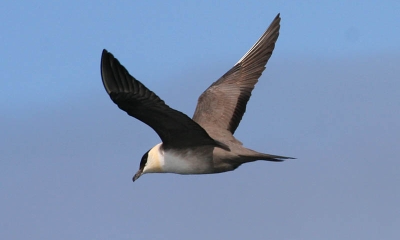
Graceful and buoyant fliers, adults are light gray-brown above with black caps, have dark flight feathers contrasting with grayer mantles and light underparts. Breeding adults have a central pair of tail feathers extremely long and pointed, extending up to eight inches past the rest of the tail.
They are not usually as aggressive as other jaegers and rely as much on food they pick from the ocean's surface as they do from food they steal from other small seabirds.
The Long-tailed jaeger is a rare to fairly common fall transient offshore. They are usually detected when Arctic terns and Sabine's gulls are in high numbers.
Hear the call of the Long-tailed jaeger
Photo by ©Greg Gilson

This mid-sized, pink-legged gull has caused much of the confusion in west coast gull classification and identification. Its plumage characteristics are similar to Herring, Iceland, and some Glaucous-winged hybrids, and great care is needed for correct identification. It differs from the Herring gull in having a much smaller bill, a darker eye, less black in the wing-tips and, often, a more rounded head.
Opportunistic feeders, Thayer's gulls regularly concentrate about landfills, food-processing plants, and over fish runs. It is a common migrant and fairly common winter visitor along the coast. The largest wintering numbers are found in the Portland metropolitan area where flocks of several hundred are not uncommon.
Hear the call of the Thayer's gull
Photo by Jerry McFarland, Flickr

